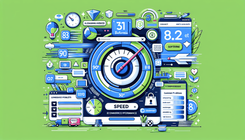Why is My Shopify Store's Loading Speed So Low? A Detailed Guide to Improve Your eCommerce Performance
Introduction
Having a fast-loading eCommerce site is crucial for user experience and SEO. Recently, many store owners have been concerned about their Shopify store's loading speed, especially when it suddenly degrades. In this blog post, we will discuss the reasons behind your Shopify store's slowed loading speed, identify common culprits, and provide actionable steps to solve these issues. We will focus on reducing unused CSS, a common yet often overlooked problem, to help you enhance your site's performance.
Understanding the Issue: Loading Speed Drop
Speed Analysis Report
A user reported that their store, theloomia.com, experienced a speed drop from 2.01 seconds to 4 seconds. Tools like Google PageSpeed Insights indicated several issues:
- Largest Contentful Paint image was lazily loaded
- Largest Contentful Paint element 1,770 ms
- Properly size images
- Serve images in next-gen formats
- Reduce unused JavaScript
- Eliminate render-blocking resources
- Minify JavaScript
- Ensure text remains visible during webfont load
- Defer offscreen images
- Reduce unused CSS
What Causes These Loading Speed Issues?
Identifying and solving these issues requires understanding their root causes:
1. Unoptimized Images
Properly sizing images and serving them in next-gen formats can greatly reduce loading times. Large, unoptimized images consume more bandwidth and slow down your site.
2. JavaScript and CSS Bloat
Excessive JavaScript and CSS files can bog down your website. Redundant code not only increases load times but can also introduce conflicts that impair functionality.
3. Render-blocking Resources
Resources that block rendering slow down the page load. This is often due to scripts that load at the start of the HTML and unused CSS that clogs the top of the document.
4. Web Fonts and Lazy Loading
Web fonts that are not properly optimized can cause significant delays. Similarly, improperly implemented lazy loading can hinder performance rather than help it.
How to Fully Solve the Problem: A Comprehensive Guide
Step 1: Optimize Images
- Resize and Compress: Use tools like TinyPNG or Squoosh to compress image sizes without losing much quality.
- Next-Gen Formats: Convert images to WebP format, which offers superior compression rates.
Step 2: Minimize JavaScript and CSS
- Code Splitting: Break up your JavaScript into smaller chunks to be loaded only when needed.
- Tree Shaking: Use build tools like Webpack to remove unused code from your JavaScript bundles.
- Minify Files: Minify all your CSS and JavaScript files to reduce their size.
Step 3: Eliminate Render-Blocking Resources
- Async and Defer: Use the
asyncordeferattributes on your script tags to prevent them from blocking rendering. - Critical CSS: Extract the critical CSS required for initial load and defer the rest.
Step 4: Optimize Web Fonts
- Font Loading API: Use the CSS
font-displayproperty to control how web fonts are displayed during load. - Preload Key Fonts: Use the
link rel='preload'directive to preload important fonts.
Step 5: Implement Lazy Loading Correctly
- Native Lazy Loading: Use the
loading='lazy'attribute for images and iframes. - Intersection Observer API: Use JavaScript to implement more advanced lazy loading for elements.
Step 6: Reduce Unused CSS
- Audit and Remove: Audit your CSS files to identify and remove unused styles. Tools like PurifyCSS or UnCSS can help.
- Modular CSS: Break CSS into smaller modules that can be loaded conditionally based on the page or component.
Frequently Asked Questions
Q: How can I identify unused CSS in my Shopify theme?
A: Tools like PurifyCSS, UnCSS, or built-in browser DevTools can help identify and remove unused CSS.
Q: What is the impact of unoptimized images on loading speed?
A: Unoptimized images can significantly increase the size of your web pages, leading to slower load times and increased data usage for visitors.
Q: Are third-party apps a common cause for slowed page speed?
A: Yes, third-party apps can introduce additional scripts and styles that inflate your page size and introduce inefficiencies.
Conclusion
Improving your Shopify store’s loading speed involves diagnosing and fixing a variety of issues, from optimizing images to reducing unused CSS. Implement the steps outlined here to make your site faster, providing a better experience for your users and boosting your SEO performance. If you continue to face issues, consider consulting with a Shopify expert for personalized assistance.




